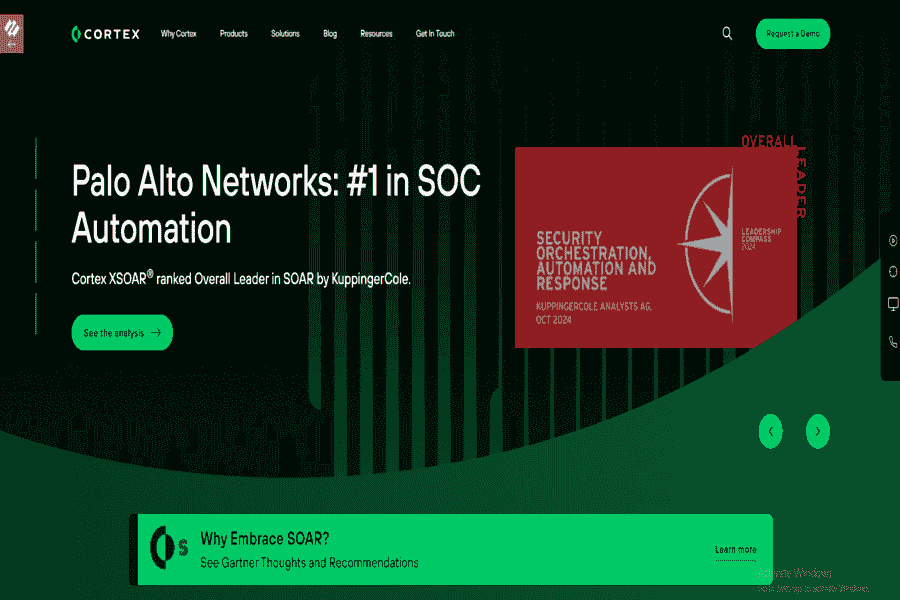Top AI Tools for Cybersecurity in 2025
December 5, 2024


AI is revolutionizing cybersecurity. AI Tools for Cybersecurity automate threat detection and response, enhancing defenses against sophisticated attacks. By effectively utilizing AI marketing tools to promote cybersecurity awareness within an organization, businesses can educate their employees about potential threats and best practices for cybersecurity, creating a more robust and informed security culture.
AI for cybersecurity refers to using artificial intelligence (AI) technologies to enhance the detection, prevention, and response to cyber threats. Here’s how AI is being used in cybersecurity:
AI algorithms can analyze vast network traffic and user behavior data to identify patterns that deviate from the norm. This helps flag potential threats like unauthorized access attempts or malware infections.
AI-powered tools can actively search for threats within networks, proactively identifying vulnerabilities and potential attacks before they cause damage.
AI can automate certain aspects of incident response, such as isolating infected systems or deploying security patches, allowing security teams to respond more quickly and effectively.
AI can automate vulnerability scanning and assessment processes, identifying weaknesses in systems and applications that attackers could exploit.
AI can help prioritize vulnerabilities based on their potential impact and likelihood of exploitation, allowing security teams to focus on the most critical issues.
AI can analyze user behavior patterns to detect anomalies indicating insider threats, such as unauthorized data access or unusual activity.
AI-powered tools can analyze emails and other communications to identify phishing attempts, helping to protect users from falling victim to social engineering attacks.
AI can automate the triage and prioritization of security alerts, reducing the workload of security analysts and allowing them to focus on the most critical issues.
AI can enrich security data with additional context, such as threat intelligence and vulnerability information, to improve the accuracy of threat detection and response.
While this may seem counterintuitive, generative AI can create realistic phishing emails to train security teams and test their ability to identify and respond to such attacks.
AI can generate security content, such as reports, policies, and procedures, helping security teams be more efficient and effective.
AI-powered SIEM solutions can automate threat detection, incident response, and security analytics.
AI-driven SOAR platforms can automate security operations, reducing response times and improving efficiency.
AI-powered IDS can detect network intrusions and anomalies in real time.
AI can analyze network traffic to identify suspicious activity and potential threats.
AI-powered EDR solutions can detect and respond to threats on endpoints.
AI can analyze user behavior to identify anomalies that may indicate malicious activity.
AI-powered email filtering can block spam, phishing, and malware.
NLP techniques can analyze email content to detect malicious intent.
Identifying unusual user behavior that may indicate a security breach.
Detecting insider threats by analyzing user activity and access patterns.

Darktrace uses AI to detect and respond to cyber threats in real-time, leveraging self-learning algorithms.
Custom pricing.

A cloud-native AI-driven platform for endpoint protection, threat intelligence, and incident response.
Custom pricing based on features.

An AI-based endpoint security tool that prevents malware and advanced threats.
Contact for pricing.

FireEye Helix is an AI-driven platform with strong incident response capabilities for detecting and managing cyber threats.
Custom pricing.

A security information and event management (SIEM) platform enhanced by AI to detect threats and manage incidents.
Contact for pricing.

A leading AI-powered SIEM platform that helps detect and respond to threats across hybrid cloud environments.
Contact for pricing.

A powerful security orchestration, automation, and response (SOAR) platform with AI-powered capabilities.
Contact for pricing.

Symantec uses AI to offer advanced threat protection for endpoints, focusing on malware detection, encryption, and vulnerability scanning.
Custom pricing.

Vectra leverages AI to detect and mitigate advanced cyber threats across networks, cloud, and endpoints.
Custom pricing.

An AI-driven endpoint protection tool that defends against ransomware, exploits, and malware.
Starts at $44/year per user.

A threat intelligence platform powered by AI, focusing on threat detection, investigation, and orchestration.
Custom pricing.

AIShield is a solution for securing AI systems against adversarial attacks, ensuring robust AI deployments.
Custom pricing.

An AI-powered deception technology platform that creates realistic decoys to detect and divert cyber threats.
Custom pricing.

FortiAI focuses on AI-driven threat detection, especially in malware and endpoint protection.
Contact for pricing.

CyberX, integrated into Azure, provides AI-driven security for IoT devices, focusing on operational technology environments.
Contact Microsoft for pricing.
AI has revolutionized the field of cybersecurity, offering numerous benefits:
AI can identify unusual patterns in network traffic or user behavior that may indicate a security breach.
AI can detect and respond to new and emerging threats that traditional security tools may miss.
AI can analyze email content and sender behavior to identify and block phishing attacks.
AI-powered tools can automate incident response processes, reducing response times and minimizing damage.
AI can continuously monitor networks for threats and respond quickly to incidents.
AI can accurately classify threats, enabling security teams to prioritize and respond effectively.
AI can minimize false alarms, reduce alert fatigue, and improve security analyst productivity.
AI can automate routine security tasks like patch management and vulnerability scanning.
AI can help security teams prioritize their efforts and allocate resources effectively.
Despite its numerous benefits, AI in cybersecurity also faces some challenges:
AI models require large amounts of high-quality data to train effectively.
Developing and deploying complex AI models can be challenging and resource-intensive.
AI-powered security tools must be used ethically and responsibly to avoid unintended consequences.
Adversaries can attempt to manipulate AI models to bypass security defenses.
Artificial Intelligence (AI) is revolutionizing the landscape of cybersecurity. Here are some of the most promising trends:
Zero-trust security is a security model that assumes no user, device, or application is inherently trustworthy. It enforces strict access controls and continuous verification.
AI-powered biometrics, behavioral analytics, and risk-based authentication can strengthen identity verification.
AI algorithms can dynamically assess user privileges based on real-time factors like location, device health, and behavior patterns.
AI can automatically adjust access policies to mitigate emerging threats and adapt to changing organizational needs.
Autonomous security operations involve AI-driven systems that can proactively detect, respond to and remediate cyber threats without human intervention.
AI can continuously scan networks for anomalies and potential threats, identifying vulnerabilities before exploitation.
AI-powered systems can automatically initiate incident response procedures, such as isolating compromised systems and deploying security patches.
AI can analyze historical data to predict future attacks, allowing organizations to take proactive measures to prevent them.
AI-powered cybersecurity training platforms can tailor learning experiences to individual user needs, improving knowledge retention and skill development.
AI can adjust training content and pace dynamically based on user performance and preferences.
AI can generate realistic cybersecurity simulations, allowing users to practice responding to real-world threats in a safe environment.
AI-powered tools can continuously assess user skills and identify areas for improvement, ensuring that training remains effective.
AI-powered tools are reshaping the cybersecurity landscape, providing organizations a formidable defense against cyber threats. By automating tedious tasks, detecting anomalies in real-time, and proactively hunting for threats, AI empowers security teams to be more efficient and effective. As AI technology advances, its potential to revolutionize cybersecurity is immense. By embracing AI-driven solutions, organizations can stay ahead of the curve, mitigate risks, and protect their digital assets in an increasingly hostile cyber environment.
